// Copyright 2010 The Go Authors. All rights reserved.
// Use of this source code is governed by a BSD-style
// license that can be found in the LICENSE file.
package json
// JSON value parser state machine.
// Just about at the limit of what is reasonable to write by hand.
// Some parts are a bit tedious, but overall it nicely factors out the
// otherwise common code from the multiple scanning functions
// in this package (Compact, Indent, checkValid, etc).
//
// This file starts with two simple examples using the scanner
// before diving into the scanner itself.
import (
"strconv"
"sync"
)
// Valid reports whether data is a valid JSON encoding.
|
|
func Valid(data []byte) bool {
scan := newScanner()
defer freeScanner(scan)
return checkValid(data, scan) == nil
}
// checkValid verifies that data is valid JSON-encoded data.
// scan is passed in for use by checkValid to avoid an allocation.
|

|
func checkValid(data []byte, scan *scanner) error {
scan.reset()
for _, c := range data {
scan.bytes++
if scan.step(scan, c) == scanError {
return scan.err
}
}
if scan.eof() == scanError {
return scan.err
}
return nil
}
// A SyntaxError is a description of a JSON syntax error.
type SyntaxError struct {
msg string // description of error
Offset int64 // error occurred after reading Offset bytes
}
|
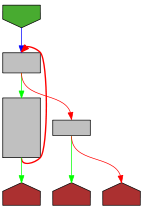
|
func (e *SyntaxError) Error() string { return e.msg }
// A scanner is a JSON scanning state machine.
// Callers call scan.reset and then pass bytes in one at a time
// by calling scan.step(&scan, c) for each byte.
// The return value, referred to as an opcode, tells the
// caller about significant parsing events like beginning
// and ending literals, objects, and arrays, so that the
// caller can follow along if it wishes.
// The return value scanEnd indicates that a single top-level
// JSON value has been completed, *before* the byte that
// just got passed in. (The indication must be delayed in order
// to recognize the end of numbers: is 123 a whole value or
// the beginning of 12345e+6?).
type scanner struct {
// The step is a func to be called to execute the next transition.
// Also tried using an integer constant and a single func
// with a switch, but using the func directly was 10% faster
// on a 64-bit Mac Mini, and it's nicer to read.
step func(*scanner, byte) int
// Reached end of top-level value.
endTop bool
// Stack of what we're in the middle of - array values, object keys, object values.
parseState []int
// Error that happened, if any.
err error
// total bytes consumed, updated by decoder.Decode (and deliberately
// not set to zero by scan.reset)
bytes int64
}
var scannerPool = sync.Pool{
|

|
New: func() any {
return &scanner{}
},
}
|

|
func newScanner() *scanner {
scan := scannerPool.Get().(*scanner)
// scan.reset by design doesn't set bytes to zero
scan.bytes = 0
scan.reset()
return scan
}
|

|
func freeScanner(scan *scanner) {
// Avoid hanging on to too much memory in extreme cases.
if len(scan.parseState) > 1024 {
scan.parseState = nil
}
scannerPool.Put(scan)
}
// These values are returned by the state transition functions
// assigned to scanner.state and the method scanner.eof.
// They give details about the current state of the scan that
// callers might be interested to know about.
// It is okay to ignore the return value of any particular
// call to scanner.state: if one call returns scanError,
// every subsequent call will return scanError too.
const (
// Continue.
scanContinue = iota // uninteresting byte
scanBeginLiteral // end implied by next result != scanContinue
scanBeginObject // begin object
scanObjectKey // just finished object key (string)
scanObjectValue // just finished non-last object value
scanEndObject // end object (implies scanObjectValue if possible)
scanBeginArray // begin array
scanArrayValue // just finished array value
scanEndArray // end array (implies scanArrayValue if possible)
scanSkipSpace // space byte; can skip; known to be last "continue" result
// Stop.
scanEnd // top-level value ended *before* this byte; known to be first "stop" result
scanError // hit an error, scanner.err.
)
// These values are stored in the parseState stack.
// They give the current state of a composite value
// being scanned. If the parser is inside a nested value
// the parseState describes the nested state, outermost at entry 0.
const (
parseObjectKey = iota // parsing object key (before colon)
parseObjectValue // parsing object value (after colon)
parseArrayValue // parsing array value
)
// This limits the max nesting depth to prevent stack overflow.
// This is permitted by https://tools.ietf.org/html/rfc7159#section-9
const maxNestingDepth = 10000
// reset prepares the scanner for use.
// It must be called before calling s.step.
|

|
func (s *scanner) reset() {
s.step = stateBeginValue
s.parseState = s.parseState[0:0]
s.err = nil
s.endTop = false
}
// eof tells the scanner that the end of input has been reached.
// It returns a scan status just as s.step does.
|

|
func (s *scanner) eof() int {
if s.err != nil {
return scanError
}
if s.endTop {
return scanEnd
}
s.step(s, ' ')
if s.endTop {
return scanEnd
}
if s.err == nil {
s.err = &SyntaxError{"unexpected end of JSON input", s.bytes}
}
return scanError
}
// pushParseState pushes a new parse state p onto the parse stack.
// an error state is returned if maxNestingDepth was exceeded, otherwise successState is returned.
|
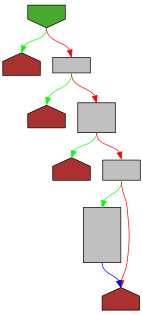
|
func (s *scanner) pushParseState(c byte, newParseState int, successState int) int {
s.parseState = append(s.parseState, newParseState)
if len(s.parseState) <= maxNestingDepth {
return successState
}
return s.error(c, "exceeded max depth")
}
// popParseState pops a parse state (already obtained) off the stack
// and updates s.step accordingly.
|

|
func (s *scanner) popParseState() {
n := len(s.parseState) - 1
s.parseState = s.parseState[0:n]
if n == 0 {
s.step = stateEndTop
s.endTop = true
} else {
s.step = stateEndValue
}
}
|

|
func isSpace(c byte) bool {
return c <= ' ' && (c == ' ' || c == '\t' || c == '\r' || c == '\n')
}
// stateBeginValueOrEmpty is the state after reading `[`.
|
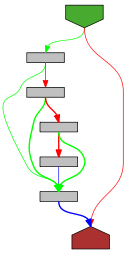
|
func stateBeginValueOrEmpty(s *scanner, c byte) int {
if isSpace(c) {
return scanSkipSpace
}
if c == ']' {
return stateEndValue(s, c)
}
return stateBeginValue(s, c)
}
// stateBeginValue is the state at the beginning of the input.
|
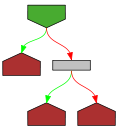
|
func stateBeginValue(s *scanner, c byte) int {
if isSpace(c) {
return scanSkipSpace
}
switch c {
case '{':
s.step = stateBeginStringOrEmpty
return s.pushParseState(c, parseObjectKey, scanBeginObject)
case '[':
s.step = stateBeginValueOrEmpty
return s.pushParseState(c, parseArrayValue, scanBeginArray)
case '"':
s.step = stateInString
return scanBeginLiteral
case '-':
s.step = stateNeg
return scanBeginLiteral
case '0': // beginning of 0.123
s.step = state0
return scanBeginLiteral
case 't': // beginning of true
s.step = stateT
return scanBeginLiteral
case 'f': // beginning of false
s.step = stateF
return scanBeginLiteral
case 'n': // beginning of null
s.step = stateN
return scanBeginLiteral
}
if '1' <= c && c <= '9' { // beginning of 1234.5
s.step = state1
return scanBeginLiteral
}
return s.error(c, "looking for beginning of value")
}
// stateBeginStringOrEmpty is the state after reading `{`.
|
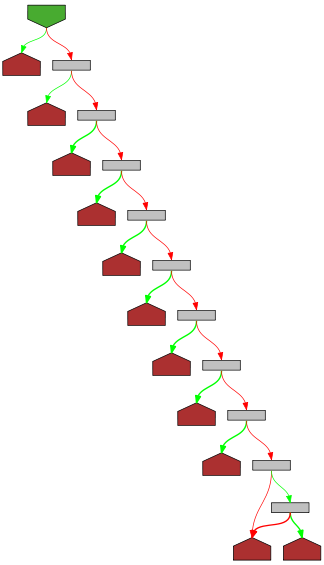
|
func stateBeginStringOrEmpty(s *scanner, c byte) int {
if isSpace(c) {
return scanSkipSpace
}
if c == '}' {
n := len(s.parseState)
s.parseState[n-1] = parseObjectValue
return stateEndValue(s, c)
}
return stateBeginString(s, c)
}
// stateBeginString is the state after reading `{"key": value,`.
|
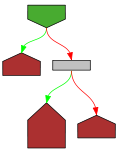
|
func stateBeginString(s *scanner, c byte) int {
if isSpace(c) {
return scanSkipSpace
}
if c == '"' {
s.step = stateInString
return scanBeginLiteral
}
return s.error(c, "looking for beginning of object key string")
}
// stateEndValue is the state after completing a value,
// such as after reading `{}` or `true` or `["x"`.
|
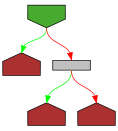
|
func stateEndValue(s *scanner, c byte) int {
n := len(s.parseState)
if n == 0 {
// Completed top-level before the current byte.
s.step = stateEndTop
s.endTop = true
return stateEndTop(s, c)
}
if isSpace(c) {
s.step = stateEndValue
return scanSkipSpace
}
ps := s.parseState[n-1]
switch ps {
case parseObjectKey:
if c == ':' {
s.parseState[n-1] = parseObjectValue
s.step = stateBeginValue
return scanObjectKey
}
return s.error(c, "after object key")
case parseObjectValue:
if c == ',' {
s.parseState[n-1] = parseObjectKey
s.step = stateBeginString
return scanObjectValue
}
if c == '}' {
s.popParseState()
return scanEndObject
}
return s.error(c, "after object key:value pair")
case parseArrayValue:
if c == ',' {
s.step = stateBeginValue
return scanArrayValue
}
if c == ']' {
s.popParseState()
return scanEndArray
}
return s.error(c, "after array element")
}
return s.error(c, "")
}
// stateEndTop is the state after finishing the top-level value,
// such as after reading `{}` or `[1,2,3]`.
// Only space characters should be seen now.
|
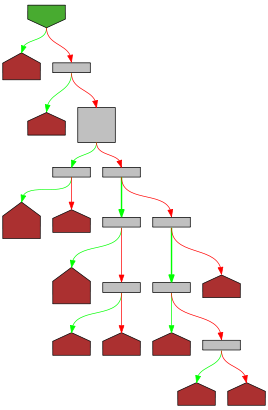
|
func stateEndTop(s *scanner, c byte) int {
if !isSpace(c) {
// Complain about non-space byte on next call.
s.error(c, "after top-level value")
}
return scanEnd
}
// stateInString is the state after reading `"`.
|

|
func stateInString(s *scanner, c byte) int {
if c == '"' {
s.step = stateEndValue
return scanContinue
}
if c == '\\' {
s.step = stateInStringEsc
return scanContinue
}
if c < 0x20 {
return s.error(c, "in string literal")
}
return scanContinue
}
// stateInStringEsc is the state after reading `"\` during a quoted string.
|
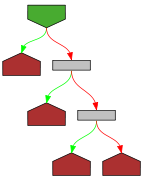
|
func stateInStringEsc(s *scanner, c byte) int {
switch c {
case 'b', 'f', 'n', 'r', 't', '\\', '/', '"':
s.step = stateInString
return scanContinue
case 'u':
s.step = stateInStringEscU
return scanContinue
}
return s.error(c, "in string escape code")
}
// stateInStringEscU is the state after reading `"\u` during a quoted string.
|
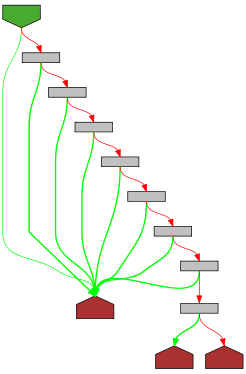
|
func stateInStringEscU(s *scanner, c byte) int {
if '0' <= c && c <= '9' || 'a' <= c && c <= 'f' || 'A' <= c && c <= 'F' {
s.step = stateInStringEscU1
return scanContinue
}
// numbers
return s.error(c, "in \\u hexadecimal character escape")
}
// stateInStringEscU1 is the state after reading `"\u1` during a quoted string.
|
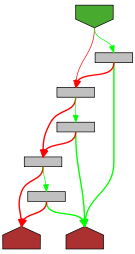
|
func stateInStringEscU1(s *scanner, c byte) int {
if '0' <= c && c <= '9' || 'a' <= c && c <= 'f' || 'A' <= c && c <= 'F' {
s.step = stateInStringEscU12
return scanContinue
}
// numbers
return s.error(c, "in \\u hexadecimal character escape")
}
// stateInStringEscU12 is the state after reading `"\u12` during a quoted string.
|
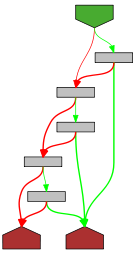
|
func stateInStringEscU12(s *scanner, c byte) int {
if '0' <= c && c <= '9' || 'a' <= c && c <= 'f' || 'A' <= c && c <= 'F' {
s.step = stateInStringEscU123
return scanContinue
}
// numbers
return s.error(c, "in \\u hexadecimal character escape")
}
// stateInStringEscU123 is the state after reading `"\u123` during a quoted string.
|
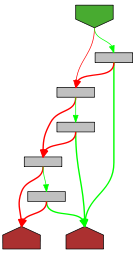
|
func stateInStringEscU123(s *scanner, c byte) int {
if '0' <= c && c <= '9' || 'a' <= c && c <= 'f' || 'A' <= c && c <= 'F' {
s.step = stateInString
return scanContinue
}
// numbers
return s.error(c, "in \\u hexadecimal character escape")
}
// stateNeg is the state after reading `-` during a number.
|
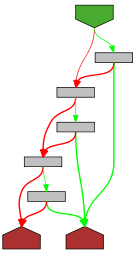
|
func stateNeg(s *scanner, c byte) int {
if c == '0' {
s.step = state0
return scanContinue
}
if '1' <= c && c <= '9' {
s.step = state1
return scanContinue
}
return s.error(c, "in numeric literal")
}
// state1 is the state after reading a non-zero integer during a number,
// such as after reading `1` or `100` but not `0`.
|
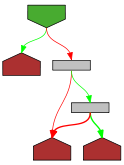
|
func state1(s *scanner, c byte) int {
if '0' <= c && c <= '9' {
s.step = state1
return scanContinue
}
return state0(s, c)
}
// state0 is the state after reading `0` during a number.
|

|
func state0(s *scanner, c byte) int {
if c == '.' {
s.step = stateDot
return scanContinue
}
if c == 'e' || c == 'E' {
s.step = stateE
return scanContinue
}
return stateEndValue(s, c)
}
// stateDot is the state after reading the integer and decimal point in a number,
// such as after reading `1.`.
|
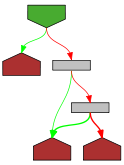
|
func stateDot(s *scanner, c byte) int {
if '0' <= c && c <= '9' {
s.step = stateDot0
return scanContinue
}
return s.error(c, "after decimal point in numeric literal")
}
// stateDot0 is the state after reading the integer, decimal point, and subsequent
// digits of a number, such as after reading `3.14`.
|

|
func stateDot0(s *scanner, c byte) int {
if '0' <= c && c <= '9' {
return scanContinue
}
if c == 'e' || c == 'E' {
s.step = stateE
return scanContinue
}
return stateEndValue(s, c)
}
// stateE is the state after reading the mantissa and e in a number,
// such as after reading `314e` or `0.314e`.
|
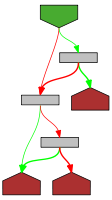
|
func stateE(s *scanner, c byte) int {
if c == '+' || c == '-' {
s.step = stateESign
return scanContinue
}
return stateESign(s, c)
}
// stateESign is the state after reading the mantissa, e, and sign in a number,
// such as after reading `314e-` or `0.314e+`.
|

|
func stateESign(s *scanner, c byte) int {
if '0' <= c && c <= '9' {
s.step = stateE0
return scanContinue
}
return s.error(c, "in exponent of numeric literal")
}
// stateE0 is the state after reading the mantissa, e, optional sign,
// and at least one digit of the exponent in a number,
// such as after reading `314e-2` or `0.314e+1` or `3.14e0`.
|

|
func stateE0(s *scanner, c byte) int {
if '0' <= c && c <= '9' {
return scanContinue
}
return stateEndValue(s, c)
}
// stateT is the state after reading `t`.
|

|
func stateT(s *scanner, c byte) int {
if c == 'r' {
s.step = stateTr
return scanContinue
}
return s.error(c, "in literal true (expecting 'r')")
}
// stateTr is the state after reading `tr`.
|

|
func stateTr(s *scanner, c byte) int {
if c == 'u' {
s.step = stateTru
return scanContinue
}
return s.error(c, "in literal true (expecting 'u')")
}
// stateTru is the state after reading `tru`.
|

|
func stateTru(s *scanner, c byte) int {
if c == 'e' {
s.step = stateEndValue
return scanContinue
}
return s.error(c, "in literal true (expecting 'e')")
}
// stateF is the state after reading `f`.
|

|
func stateF(s *scanner, c byte) int {
if c == 'a' {
s.step = stateFa
return scanContinue
}
return s.error(c, "in literal false (expecting 'a')")
}
// stateFa is the state after reading `fa`.
|

|
func stateFa(s *scanner, c byte) int {
if c == 'l' {
s.step = stateFal
return scanContinue
}
return s.error(c, "in literal false (expecting 'l')")
}
// stateFal is the state after reading `fal`.
|

|
func stateFal(s *scanner, c byte) int {
if c == 's' {
s.step = stateFals
return scanContinue
}
return s.error(c, "in literal false (expecting 's')")
}
// stateFals is the state after reading `fals`.
|

|
func stateFals(s *scanner, c byte) int {
if c == 'e' {
s.step = stateEndValue
return scanContinue
}
return s.error(c, "in literal false (expecting 'e')")
}
// stateN is the state after reading `n`.
|

|
func stateN(s *scanner, c byte) int {
if c == 'u' {
s.step = stateNu
return scanContinue
}
return s.error(c, "in literal null (expecting 'u')")
}
// stateNu is the state after reading `nu`.
|

|
func stateNu(s *scanner, c byte) int {
if c == 'l' {
s.step = stateNul
return scanContinue
}
return s.error(c, "in literal null (expecting 'l')")
}
// stateNul is the state after reading `nul`.
|

|
func stateNul(s *scanner, c byte) int {
if c == 'l' {
s.step = stateEndValue
return scanContinue
}
return s.error(c, "in literal null (expecting 'l')")
}
// stateError is the state after reaching a syntax error,
// such as after reading `[1}` or `5.1.2`.
|

|
func stateError(s *scanner, c byte) int {
return scanError
}
// error records an error and switches to the error state.
|

|
func (s *scanner) error(c byte, context string) int {
s.step = stateError
s.err = &SyntaxError{"invalid character " + quoteChar(c) + " " + context, s.bytes}
return scanError
}
// quoteChar formats c as a quoted character literal
|

|
func quoteChar(c byte) string {
// special cases - different from quoted strings
if c == '\'' {
return `'\''`
}
if c == '"' {
return `'"'`
}
// use quoted string with different quotation marks
s := strconv.Quote(string(c))
return "'" + s[1:len(s)-1] + "'"
}
|
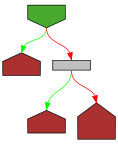
|











































